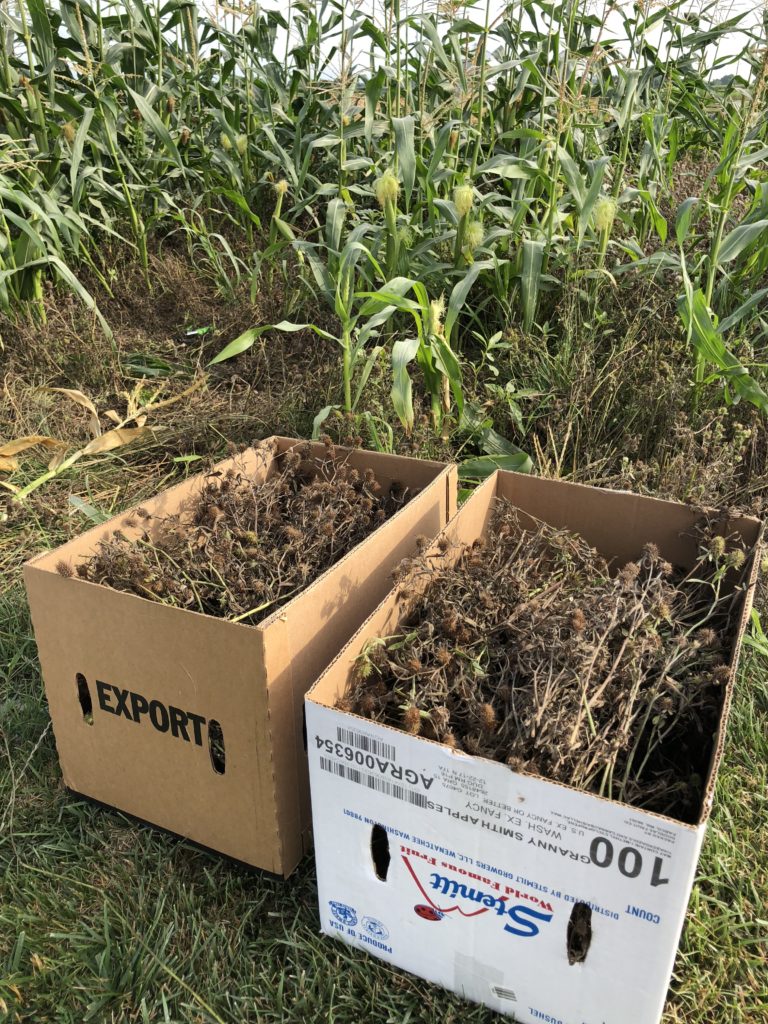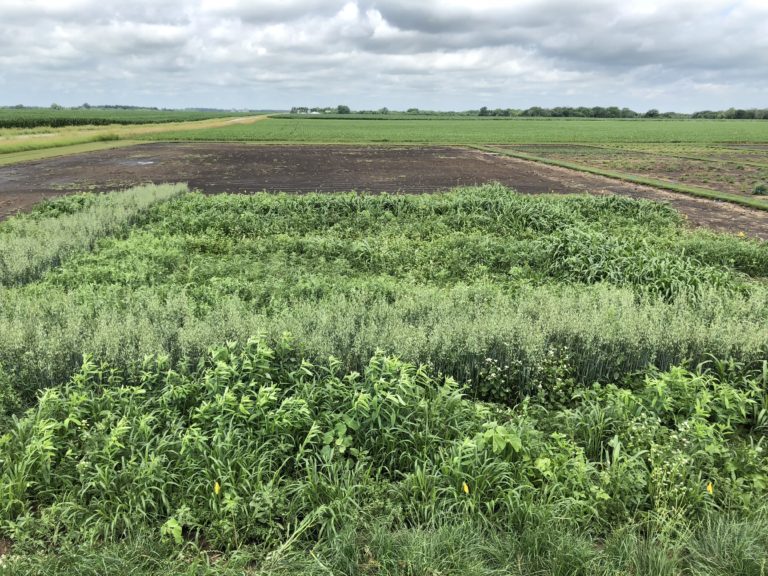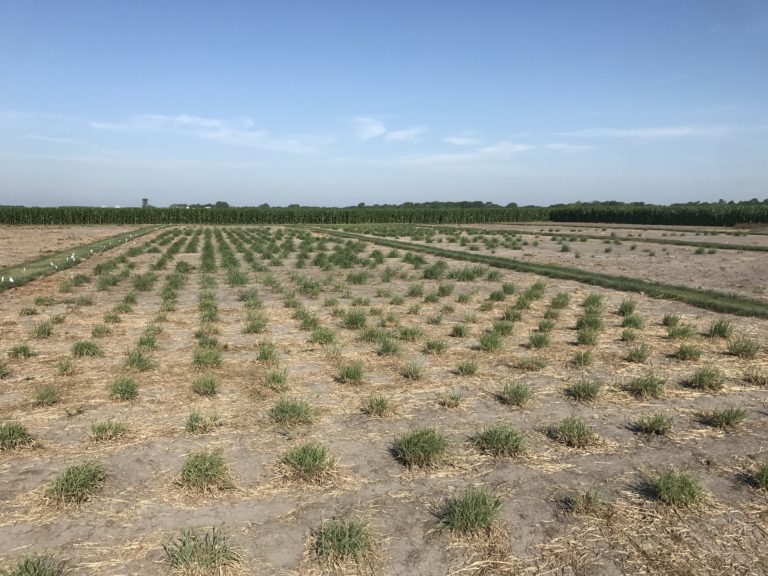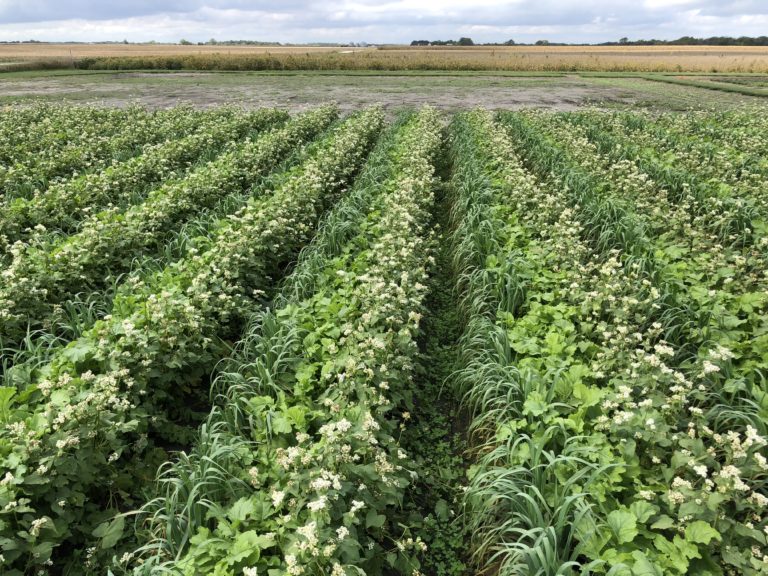Looking back at the 2018 growing season at our Richland, Iowa Research Farm, it was quite a condensed season. We had the coldest April in 100 years. I learned that the normal flowering dates for our clovers were pushed back 4-6 days and forage production was cut drastically. FIXatioN Balansa Clover forage production was less than half of what it was in the Spring of 2017. Snow and below-freezing temperatures into the last week of April really limited forage production and while the flowering dates were a bit later, they couldn’t make up for the 3 weeks of growth they missed out on.
Even with a very cold, extended winter and short Spring, we had quite a bit of Frosty Berseem Clover plants that survived the winter. As in the past, these plants are allowed to flower and seed is collected. The seed from the surviving plants is then planted back again in Iowa to further select for greater cold tolerance.

In the Fall of 2017, I planted a silage trial consisting of rows of WinterMax and HyOctane Triticale as well as Hood Barley. While WinterMax showed some great traits in the fall, such as upright growth and quick establishment, being bred in New Zealand, it lacked cold tolerance and did not survive the winter. Hood Barley also had a very low survival rate. HyOctane had nearly 100% winter survival. Between the grain rows, I planted Survivor Peas which had a very high survival rate also. The HyOctane & Survivor section produced a large forage harvest in May.
Another trial I planted in the fall of 2017 was a matrix of Albion Tetraploid Perennial Ryegrass with different Clovers (FIXatioN Balansa, Frosty Berseem, Kentucky Pride Crimson, AberLasting Hybrid, and Domino White). I had 2 reps of each clover/Albion mix. The highest-yielding plots were the FIXatioN Balansa/Albion plots. Frosty had quite a bit of winterkill which we expected. Kentucky Pride, AberLasting, and Domino all had excellent survival rates and forage production. By the fall of 2018, AberLasting and Domino were looking very strong but not overwhelming the Albion.
In May, when the soil dried out and warmed up, I planted a Spring Cover Crop Matrix. The species planted were White Mustard, Purple Top Turnips, German Millet, Daikon Radish, Buckwheat, Phacelia, Frosty Berseem, Survivor Winter Peas, Spring Oats, and Sun Hemp. The purpose of this trial was to see what combination of the two species was the best at suppressing weeds. I posted a detailed blog about the findings last summer.

An idea Jerry and I came up with last Spring was to simulate strip-tilling corn into plots of clovers planted in the Fall of 2017. The clovers were FIXatioN, Frosty, Kentucky Pride, and AberLasting. The Clovers all did a good job of suppressing weeds and adding Nitrogen to the corn in May. What we learned is that a 6” strip is not nearly wide enough. When the clovers hit their spring growth spurt in early May, they proved to be too much competition for the corn in many places. What we saw in AberLasting was a great promise as a perennial cover crop product. More on that in the seasons to come.
The Summer of 2018 marked the end of our Forage Grass Maturity Trial. In the fall of 2016, I planted plants from 8 different species and 72 different forage varieties. The data collected on plant maturities of these varieties will help develop a forage grass maturity index to help producers select varieties that meet their forage production needs.

In September of this year, I started planting plots and trials for the Spring of 2019. I planted a plot of our experimental Persian Clover variety to see how it does after a cold, roller coaster Iowa Winter. I planted a plot of a new wildlife food plot consisting of FIXatioN Balansa Clover and Dwarf Essex Rape. Jerry fell in love with this mix because the seeds are Oregon State Beaver colors. That makes sense, right?
I planted another silage trial with HyOctane Triticale as the grain component and a section with Survivor Peas and another with FIXatioN Balansa Clover. Next Spring I will measure forage output and forage quality on both.
The coolest trial planted last Fall was my Bio-Strip trial. I planted 3 rows, 6” apart of Buckwheat, Driller Radish, and Oats. They all put on a tremendous amount of growth and will winter-kill. Between reps of the 3 winterkill species I have an 18” wide strip of clover. I planted FIXatioN Balansa, Kentucky Pride Crimson, and AberLasting Hybrid. Next April, the goal is to plant corn between the rows of Buckwheat and Radish. The soil in that winter-killed strip should be full of nutrients and very mellow. The residue should suppress Spring weeds as well. The annual clovers between the corn rows should help suppress weeds and give the corn a shot of Nitrogen over the summer. The AberLasting will provide ground cover between corn rows and likely provide some Nitrogen as well.

As I write this blog, it is 20° outside with a 4° wind chill. It will be a long winter of fighting to survive out in Richland. I’m looking forward to seeing what comes out the other side!
For a printable, PDF version of this blog, click below.




